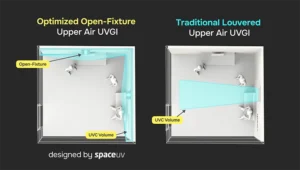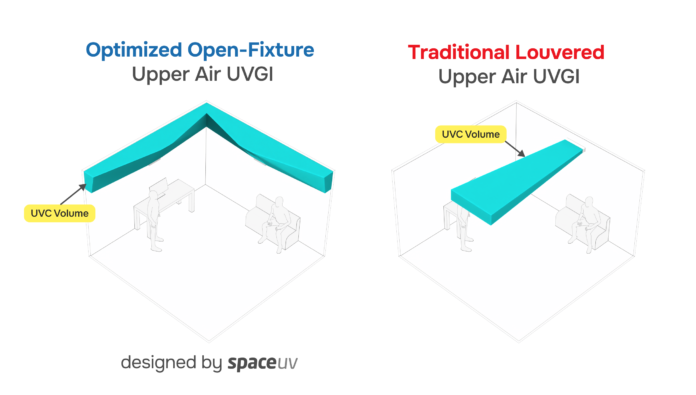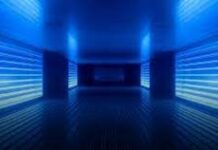Shreeneet Rathi, SpaceUV
Editor’s Note: Shreeneet Rathi presented “A new era of Upper Air UVGI Fixtures” at the 2023 IUVA World Congress. This Innovation Column expands on the technology discussed during that presentation.
Indoor air quality (IAQ) is a critical factor in maintaining healthy and safe environments, especially in healthcare settings and densely occupied spaces. Traditional methods of air disinfection often fall short due to limitations in efficiency, efficacy, cost and adaptability to diverse indoor settings. The author’s company has pioneered a new approach by leveraging advanced multiphysics simulations to rapidly evaluate, develop and validate in real scales a new generation of Upper Air UVGI fixtures. The approach fundamentally reimagines the delivery of germicidal UV-C in the upper volume of a human-occupied space.
 Upper Air UVGI, as a technology, is nearly a century old; it is well-studied and has multiple published long-term studies indicating its efficacy in preventing cross infections. The core principle of Upper Air UVGI is to create two zones within human-occupied indoor space: an upper germicidal zone actively irradiated with UV-C and a lower human-occupied zone with UV-C below threshold limit value (TLV) limits for safe human occupancy. When properly implemented, this method of germicidal UV-C delivery facilitates rapid air disinfection in human-occupied spaces, achieving 12-30 equivalent air changes per hour (eACH) of clean airflow at a fraction of energy costs. Upper Air UVGI devices operate silently, often consume less than 50 W (typically 10-36 W per fixture) and deliver high eACH at factor of magnitude lower energy costs compared to other engineering solutions, thereby enabling a valid choice toward sustainable decarbonization of IAQ compliances, especially in line with the clean airflow requirements specified in ASHRAE 241.
Upper Air UVGI, as a technology, is nearly a century old; it is well-studied and has multiple published long-term studies indicating its efficacy in preventing cross infections. The core principle of Upper Air UVGI is to create two zones within human-occupied indoor space: an upper germicidal zone actively irradiated with UV-C and a lower human-occupied zone with UV-C below threshold limit value (TLV) limits for safe human occupancy. When properly implemented, this method of germicidal UV-C delivery facilitates rapid air disinfection in human-occupied spaces, achieving 12-30 equivalent air changes per hour (eACH) of clean airflow at a fraction of energy costs. Upper Air UVGI devices operate silently, often consume less than 50 W (typically 10-36 W per fixture) and deliver high eACH at factor of magnitude lower energy costs compared to other engineering solutions, thereby enabling a valid choice toward sustainable decarbonization of IAQ compliances, especially in line with the clean airflow requirements specified in ASHRAE 241.
Addressing Current Challenges
The design of Upper Air UVGI fixtures largely has remained unchanged for nearly a century, relying on highly specular (often parabolic) reflectors to concentrate and direct UV-C photons emitted by low-pressure mercury lamps into smaller volumes with clear cut-offs. Despite numerous efforts to deploy these fixtures in high-impact indoor spaces in developing nations, widespread adoption has been limited due to several key challenges:
Fixture-Level Challenges
Conventional Upper Air UVGI fixtures using low-pressure mercury vapor lamps have low optical efficiencies (~0.1% to ~2%) due to their inherent dependencies on specular reflectivity of the reflector and the performance of the manufactured reflector profile. Use of densely spaced UV-C attenuating louvers adds further to reduced optical efficiencies. The lifespan of these fixtures is limited by the rate of oxidation of specular reflector surfaces and the breakdown of UV-C absorbing coatings on the louvers. These fixtures also require large amounts of functional material for construction.
Application-Level Challenges
In regions like India, high ambient dust is common, and this dust settles over functional reflecting surfaces (lamps and the reflectors), thereby substantially reducing the effective germicidal UV-C output of traditional horizontal axis parabolic reflector-based fixtures, reducing their germicidal efficacy unless frequently cleaned. Not only is it difficult to frequently clean the fixture surfaces, but repeated cleaning of these surfaces degrades the specular optical reflectance properties of the functional surfaces.
Commercial and Safety Challenges
Traditional fixtures often require high-wattage UV-C lamps (~28 W to ~40 W) to offset their low optical efficiencies; moreover, these designs concentrate very high-intensity UV-C irradiance in relatively small germicidal volumes (often 500 to 100 uW/sq.cm within two-feets distance from the fixture), posing a safety risk of UV-C side effects in accidental human exposure. These fixtures also require extensive, densely spaced louvers, which increases the material required for fixture construction, adding to the manufacturing costs.
SpaceUV: Innovations with Strategic Germicidal UV-C Dose Delivery
The primary objective of Upper Air UVGI devices is to rapidly inactivate bioaerosols in substantial volumes of room air. At the author’s company, the approach diverges from traditional fixtures, with a focus on generating large volumes of germicidal UV-C zones at lower intensities, which facilitates more rapid air disinfection compared to traditional devices that concentrate high-intensity UV-C in smaller germicidal volumes.
Leveraging advanced raytrace simulations, novel methods were developed to deliver higher UV-C doses to bioaerosols in indoor spaces while adhering to stringent TLV and photobiological safety limits, as specified by ACGIH and IEC-62471. To date, six unique Upper Air UVGI fixture configurations have been designed, developed and validated, addressing unique requirements and key challenges specific to regions like India, from healthcare facilities to common office spaces.
Enhanced UV-C Delivery
Traditional UVGI fixtures typically employ high-intensity UV-C lamps with parabolic reflectors and multiple louvers, resulting in low optical efficiencies (0.3% to 2%). The author’s company’s approach uses optimized open-fixture configurations with modern reflective surfaces that maintain performance over several years. Up to 14x increases in optical efficiency of fixture have been achieved, enabling the use of low-wattage UV-C lamps. This design delivers ~2x more overall germicidal UV-C doses through ~3x larger germicidal volumes (16″ x 30″ x 10 feet) with relatively lower intensity, ensuring effective disinfection while minimizing risks in case of accidental human exposure.
Sustainability and Efficiency
The fixture designs eliminate the need for high-specular reflectors, instead utilizing chemically inert, durable and easy-to-maintain diffused surfaces. This configuration also eliminates the need for densely spaced louvers. These innovations together reduce material and energy costs for manufacturing as well as extend the fixture lifespan, lowering the total cost of ownership. The fixtures operate effectively with lamps as low as ~8W.
Simulation-Driven Design
Using advanced multi-physics simulations, behavior is modeled by mapping intensity, direction and number of reflections done by billions of UV-C photons within the fixture and at room level. This includes modeling and simulation of optical, fluid and mechanical interactions, ensuring highly representative system design. These simulated design configurations have been validated in full-scale prototypes, followed by application-level installations in healthcare facilities.
With average ray tracing of over 5 billion photons, the simulations allow the evaluation and refinement of the optical efficiency of different reflector geometries and germicidal UV-C profiles, as well as experimentation with the presence and absence of louvers in the fixture design. The simulations also account for real-world variables, such as room dimensions, ceiling height, reflectance of ceiling and wall surfaces.
Safety and Compliance
Fixtures are installed with advanced control systems that use accurate Time-of-Flight sensors to detect human presence in the germicidal UV-C volume and react in near-real-time by either switching off the UV-C lamps or triggering auditory alarms to minimize the risks of accidental overexposure of UV-C. The fixtures comply with all relevant photobiological TLV levels, maintaining UV-C exposure below <0.2 µW/cm² in human-occupied zones, and meet safety standards, including ISO 15858, ACGIH and IEC 62471.
Conclusion
The company’s next step involves integrating IoT capabilities for condition-based maintenance of lamps, allowing real-time monitoring and automated alerts for lamp replacements based on actual performance metrics. This will further enhance the operational efficiency and reliability of the fixtures.
SpaceUV Systems is at the forefront of UVGI technology, specializing in advanced Upper Air UVGI system designs. By combining multi-physics simulations with innovative design principles, the company delivers air disinfection solutions that ensure compliance with indoor air quality (IAQ) norms while minimizing cross-infection risks for occupants. SpaceUV Systems remains committed to enhancing public health and safety through advanced engineering and thoughtful design. Collaborations in the form of consultancy for fixture design or licensing the fixtures for manufacturing and marketing in new regions are invited. For more information, visit www.spaceuv.com.






